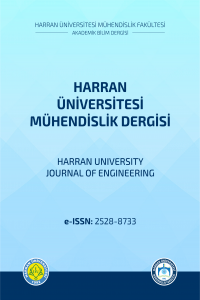ÇAMURUN HİDROTERMAL KARBONİZASYONU
Hidrotermal karbonizasyon, çamur arıtımı, biyokömür
___
- [1] Xu X, Jiang E. Treatment of urban sludge by hydrothermal carbonization. Bioresour Technol 2017;238:182–7. doi:10.1016/j.biortech.2017.03.174.
- [2] Danso-Boateng E, Shama G, Wheatley AD, Martin SJ, Holdich RG. Hydrothermal carbonisation of sewage sludge: Effect of process conditions on product characteristics and methane production. Bioresour Technol 2015;177:318–27. doi:10.1016/j.biortech.2014.11.096.
- [3] Aydıncak K. Hidrotermal Karboni̇zasyon Yöntemi̇yle Gerçek Ve Model Bi̇yokütlelerden Karbon Nanoküre Sentezi̇ ve Karakteri̇zasyonu. Yüksek Li̇sans Tezi̇ 2012.
- [4] Ramke H, Blöhse D, Lehmann H, Fettig J. Hydrothermal Carbonization of Organic Waste. Twelfth Int Waste Manag Landfill Symp 2009.
- [5] Kabadayi A. Investigation of Reusability of Process Water in the Hydrothermal Carbonization of Biomass 2016.
- [6] Mäkelä M, Benavente V, Fullana A. Hydrothermal carbonization of industrial mixed sludge from a pulp and paper mill. Bioresour Technol 2016;200:444–50. doi:10.1016/j.biortech.2015.10.062.
- [7] Child M. Industrial-Scale Hydrothermal Carbonization of Waste Sludge Materials for Fuel Production. Thesis 2014:1–109.
- [8] Nizamuddin S, Baloch HA, Griffin GJ, Mubarak NM, Bhutto AW, Abro R, et al. An overview of effect of process parameters on hydrothermal carbonization of biomass. Renew Sustain Energy Rev 2017;73:1289–99. doi:10.1016/j.rser.2016.12.122.
- [9] Funke A, Ziegler F. Hydrothermal carbonization of biomass: A summary and discussion of chemical mechanisms for process engineering. Biofuels, Bioprod Biorefining 2010;4:160–77. doi:10.1002/bbb.198.
- [10] Stemann J, Putschew A, Ziegler F. Hydrothermal carbonization: Process water characterization and effects of water recirculation. Bioresour Technol 2013;143:139–46. doi:10.1016/j.biortech.2013.05.098.
- [11] Hoekman SK, Broch A, Robbins C. Hydrothermal carbonization of lignocellulosic biomass. Energy & Fuels 2011;25:1802–10. doi:10.1016/j.biortech.2012.05.060.
- [12] Libra JA, Ro KS, Kammann C, Funke A, Berge ND, Neubauer Y, et al. Hydrothermal carbonization of biomass residuals: A comparative review of the chemistry, processes and applications of wet and dry pyrolysis. Biofuels 2011;2:71–106. doi:10.4155/bfs.10.81.
- [13] Lu X, Jordan B, Berge ND. Thermal conversion of municipal solid waste via hydrothermal carbonization: Comparison of carbonization products to products from current waste management techniques. Waste Manag 2012;32:1353–65. doi:10.1016/j.wasman.2012.02.012.
- [14] Sevilla M, Fuertes AB, Mokaya R. High density hydrogen storage in superactivated carbons from hydrothermally carbonized renewable organic materials. Energy Environ Sci 2011;4:1400–10. doi:10.1039/c0ee00347f.
- [15] Xiao LP, Shi ZJ, Xu F, Sun RC. Hydrothermal carbonization of lignocellulosic biomass. Bioresour Technol 2012;118:619–23. doi:10.1016/j.biortech.2012.05.060.
- [16] Yan W, Hastings JT, Acharjee TC, Coronella CJ, Vásquez VR. Mass and energy balances of wet torrefaction of lignocellulosic biomass. Energy and Fuels, vol. 24, 2010, p. 4738–42. doi:10.1021/ef901273n.
- [17] Berge ND, Ro KS, Mao J, Flora JR V., Chappell MA, Bae S. Hydrothermal Carbonization of Municipal Waste Streams. Environ Sci Technol 2011;45:5696–703. doi:10.1021/es2004528.
- [18] Koottatep T, Fakkaew K, Tajai N, Pradeep S V., Polprasert C. Sludge stabilization and energy recovery by hydrothermal carbonization process. Renew Energy 2016;99:978–85. doi:10.1016/j.renene.2016.07.068.
- [19] Mau V, Quance J, Posmanik R, Gross A. Phases’ characteristics of poultry litter hydrothermal carbonization under a range of process parameters. Bioresour Technol 2016;219:632–42. doi:10.1016/j.biortech.2016.08.027.
- [20] Danso-Boateng E, Holdich RG, Wheatley AD, Martin SJ, Shama G. Hydrothermal carbonization of primary sewage sludge and synthetic faeces: Effect of reaction temperature and time on filterability. Environ Prog Sustain Energy 2015;34:1279–90. doi:10.1002/ep.12114.
- [21] Breulmann M, van Afferden M, M�ller RA, Schulz E, F�hner C. Process conditions of pyrolysis and hydrothermal carbonization affect the potential of sewage sludge for soil carbon sequestration and amelioration. J Anal Appl Pyrolysis 2017;124:256–65. doi:10.1016/j.jaap.2017.01.026.
- [22] Escala M, Zumbu T, Koller C, Junge R, Krebs R. Hydrothermal Carbonization as an Energy-E ffi cient Alternative to Established Drying Technologies for Sewage Sludge : A Feasibility Study on a Laboratory Scale 2013. doi:10.1021/ef3015266.
- [23] vom Eyser C, Palmu K, Schmidt TC, Tuerk J. Pharmaceutical load in sewage sludge and biochar produced by hydrothermal carbonization. Sci Total Environ 2015;537:180–6. doi:10.1016/j.scitotenv.2015.08.021.
- [24] He C, Giannis A, Wang JY. Conversion of sewage sludge to clean solid fuel using hydrothermal carbonization: Hydrochar fuel characteristics and combustion behavior. Appl Energy 2013;111:257–66. doi:10.1016/j.apenergy.2013.04.084.
- [25] Kim D, Lee K, Park KY. Hydrothermal carbonization of anaerobically digested sludge for solid fuel production and energy recovery. Fuel 2014;130:120–5. doi:10.1016/j.fuel.2014.04.030.
- [26] Kim D, Lee K, Park KY. Enhancement of biogas production from anaerobic digestion of waste activated sludge by hydrothermal pre-treatment. Int Biodeterior Biodegrad 2015;101:42–6. doi:10.1016/j.ibiod.2015.03.025.
- [27] Zhang J hong, Lin Q mei, Zhao X rong. The hydrochar characters of municipal sewage sludge under different hydrothermal temperatures and durations. J Integr Agric 2014;13:471–82. doi:10.1016/S2095-3119(13)60702-9.
- [28] Mäkelä M, Benavente V, Fullana A. Hydrothermal carbonization of industrial mixed sludge from a pulp and paper mill. Bioresour Technol 2016;200:444–50. doi:10.1016/j.biortech.2015.10.062.
- [29] Moon J, Mun TY, Yang W, Lee U, Hwang J, Jang E, et al. Effects of hydrothermal treatment of sewage sludge on pyrolysis and steam gasification. Energy Convers Manag 2015;103:401–7. doi:10.1016/j.enconman.2015.06.058.
- Yayın Aralığı: Yılda 3 Sayı
- Başlangıç: 2016
- Yayıncı: Harran Üniversitesi
Hidrolojik Kuraklık Değerlendirmesi: Murat Nehri-Palu Örneği
Veysel GÜMÜŞ, Mustafa Semih YILDIZ, Oğuz ŞİMŞEK
İki Boyutlu Çelik Çerçevelerin Sismik Yükler Altında Zemin Yapı Etkileşimli Analizi
Kazı Aşamaları Dikkate Alınarak Derin Kazı Sistemlerinin Üç Boyutlu Sonlu Elemanlar Analizi
Halil Murat ALĞIN, Arda Burak EKMEN, Egemen KAYA
Tamer EREN, Cemre TAŞ, Neşet BEDİR
Cr2O3 Katkılı Çeliklerin Toz Metalurjisi Yöntemiyle Üretilmesi ve Karakterizasyonu
Abuzer AÇIKGÖZ, Bülent AKTAŞ, Faik ELEK, Hasan KARAYTU, Emin KAYA, Ahmet KARAKAŞ
Düzlemsel Tip Güneş Kollektörlerde Verim Artırıcı Uygulamalar
Cenap GÜVEN, Ersan KIRAR, Yusuf IŞIKER, M. Azmi AKTACİR
AMELİYATHANELERİN PERFORMANSLARINA ETKİ EDEN FAKTÖRLERİN BULANIK AHP İLE DEĞERLENDİRMESİ
Adıyaman İleri Biyolojik Atıksu Arıtma Tesisinde Arıtma Çamurundan Biyogaz Üretimi
Harun TÜRKMENLER, Mehmet Fatih DİLEKOĞLU, Mustafa ASLAN, Zeynep Ruşen CAN
GAP Bölgesi’nde Yenilenebilir Enerji Kaynakları ve Çevresel Etkileri
